 Regia Marina – Six destroyers:
Regia Marina – Six destroyers:Indomito, Impavido, Impetusoso, Insidioso, Intrepido, Irrequieto 1911-1944
WW2 Italian Destroyers
Poerio | Aquila | Mirabello | Leone | Sella | Sauro | Turbine | Navigatori | Freccia | Folgore | Maestrale | Oriani | Soldati | Medaglie d’OroWW2 Italian Torpedo Boats
Indomito | Audace | Audace(ii) | Pilo | Sirtori | La Masa | Generali | Palestro | Curtatone | Albatros | Spica | Pegaso | Ciclone | ArieteIndomito class Destroyers (1912):
We start a deep dive into Regia Marina’s destroyers by the Indomito class. Not with the earlier Soldati class (1906), or Ascaro, because the six Indomito were of a new design with forecastle which was followed for all subsequent classes (Ardito, Audace, Pilo, Sirtori, La Masa, Patestro, Curtatone, Generali…), but also one of these, Insidioso was also active in WW2 (as a torpedo boat), and this will be chonological, until the Medaglioro d’Oro class.
The Indomito were larger than the Soldati (770t versus 412t fully loaded), were better armed with a 120 mm main gun, three AA guns and they were faster, with more than twice as much output. Apart Intrepido sunk in 1915 and Impetuoso that was sunk in 1916, three served until 1937 and Insidioso became a target ship for submarines in 1939.
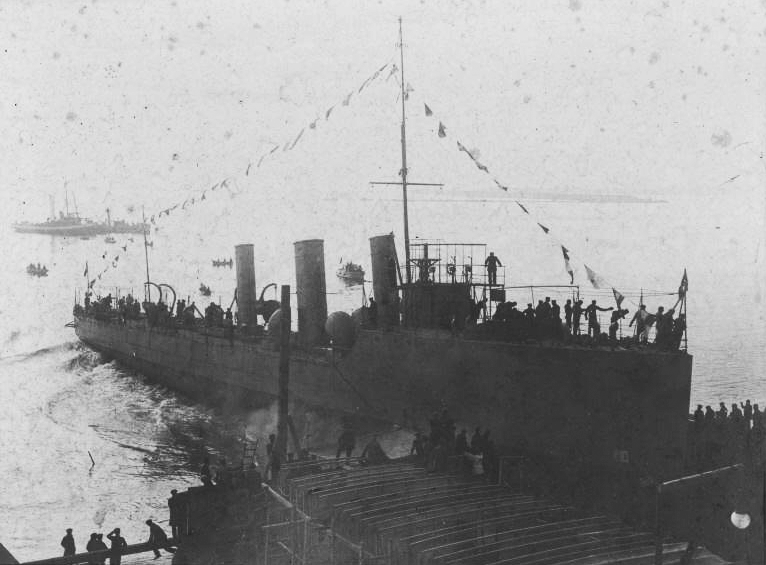
Development
Like in most countries, Italian destroyers evolved from torpedo boats, as a way to intercept and destroy them. The name in Italian was “contratorpediniere”, which was self-explanatory. The first ever class were the Soldati, built in two groups with nine ships total. They were closely derived from Nembo/Lampo class built in Germany and in Pattison Naples, while the larger Soldati were from Ansaldo. However, following what was done in other countries, notably Great Britain in 1903, the River class introduced the forecastle. More so, these also had (a few of them) steam turbines, which seemed the way forward.
The INDOMITO (or “I”) class destroyers thus became the first large Italian destroyers and first fitted with turbines. They were designed by Eng Luigi Scaglia of Pattison, Naples. In the Italian Navy, from this class onwards all 3-funnelled destroyers (until the Generali class destroyers launched in 1921-22) and were commonly known as the ‘tre pipe’ or ‘tre canne’, from the number of their funnels. They were all ordered to Pattison, Naples.
A near-class was built (Conways fully separate them based on differing specs) to Orlando, Ardito, and is seen below.
About the Pattison shipyard
In 1864, Newcastle industrialist John Pattison, in 1853 in partnership with Thomas Richard Guppy from Bristol, (Guppy & Co, Naples) started a shipyard with about 600 workers at the time. It was strategically placed near the Naples-Portici railway. Pattison factories extended their metallurgy and foundry actovities, and over the following decades, its footprint as well, gradually acquiring other adjacent factories and and creating the shipyard on Gigli Beach. In 1886 it was 24,000 m2. In 1886, a merger between the Neapolitan company Guppy and engineering firm Hawthorn Leslie of Newcastle gave birth to Hawthorn-Guppy. In 1904 Officine Meccaniche from Milan acquired Società Industriale Napoletana Hawthorn-Guppy and the same year Officine e Cantieri Napoletani Pattison is created. Industry obtained a significant share of public orders and the Pattison shipyards specialized in torpedo boat and destroyer type for the Regia Marina, seeing action in the Italo-Turkish war and First World War. In 1911, Società Bacini & Scali Napoletani created two new launching slipways and two masonry dry docks to increased war production.
Design of the class
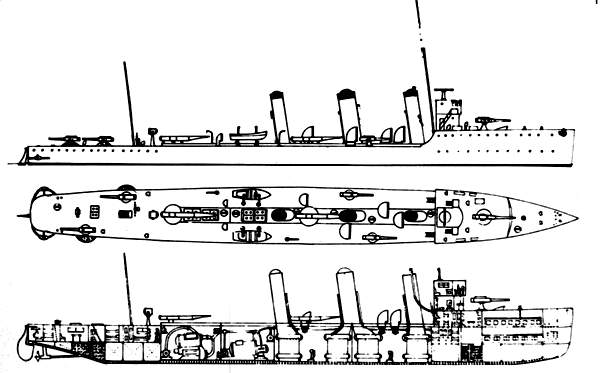
The Indomito class was designed by Luigi Scaglia at the Societa Pattison of Naples. As the first large destroyers of the Regia Marina, first with forecastle and first fitted with steam turbines they embodied a completely new wave of destroyers designs for decades in Italy. The “tre pipe” came however from a yard linked to British Yards and engineering, and so they were believed to be the first to pull out such design.
The core class comprised six ships all built at Pattison, but also Ardente and Ardito made at Orlando, Livorno (4 April 1912, 15 December 1912, comp. 15 August 1913) and her sister launched on 20 October 1912, completed in 1914. They are considered often a separate class, but for the needs of simplifications and practicity they will be seen here as well.
Hull and general design
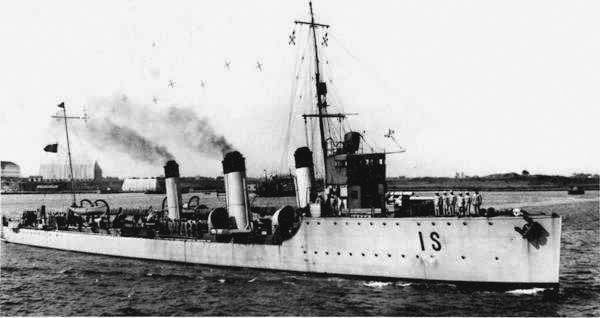
The ships were 237 feet 11 inches (72.52 m) at the waterline (239 feet 6 inches (73.00 m) overall) with a beam of 24 feet (7.3 m) and a draft of 7 feet 11 inches (2.41 m)
Powerplant
These destroyers had twin shafts driven by two Tosi steam turbines that were fired by four Thornycroft boilers. The machinery was designed for a power output of 16,000 horsepower (12,000 kW) for these to reach 30 knots (56 km/h; 35 mph), but thanks to a forced, maximum output of 17,620 shaft horsepower (13,140 kW) on trials with a lake-like sea state and on light load, they could reach 35.79 knots (66.28 km/h or 41.19 mph). Yet they would keep the figure of 30 knots (56 km/h; 35 mph) as designed. The Orlando boats were heavier and thus a bit slower.
Endurance was not greater than the previous Nembo or Soldatu class and fitting for the Mediterranean with a range of 1,200 nmi (2,200 km; 1,400 mi) at 14 knots (26 km/h; 16 mph) and at higher speeds like 25 kn (46 km/h), still some 500 nmi (930 km) and at max 30 kn (56 km/h) still 350 nmi (650 km).
Oil capacity was also increased during the war by modifying accomodations in order to carry from 100 metric tons (110 short tons) to 128 metric tons (141 short tons) and increase endurance, but this increased weight had the opposite effect.
Armament
As built, their rmament was much increased: They received a unlike their forebears a much heavier 4.7 in (120 mm)/40 gun on the forcastle, and had the same four 3 in (76 mm)/40 guns as before, but all on the lower after deck and in echelon to optimize cross-deck fire, as well as two 17.7 in (450 mm) torpedo tubes. In 1914 two more torpedo tubes were added. Also soon two guide rails for laying up to ten mines were added at the stern. In 1916-17 they were upgraded with five much faster 4 in (100 mm)/35 and a single 40 mm (1.6 in)/39 AA gun.
Main: 4.7 in (120 mm)/40
It was a British gun produced under licence by Ansaldo, Genoa. The gun was mounted on the forecastle which was reinforced. It was unmasked.
Barrel & breech: 4,592 lb
Barrel length: 189-inch bore (40 cal), 4.724 inches (120 mm)
Crew: 10
Shell: Separate loading QF, AP, Shrapnel, HE 45 pounds (20.41 kg)
Breech: Single motion interrupted screw, recoil 12 inches (305 mm)
Elevation: -6° – 20°
Rate of fire: 5–6 rounds per minute
Muzzle velocity: 544 m/s gunpowder, 660 m/s with cordite
Max range: 10,000 yards (9,100 m) at 20°, 12,000 yards (11,000 m) at 24°
Secondary
These four guns were installed by echeloned pairs, one close to amidship forefunnel, the other aft nearly at the poop, and sponsoned.
They were another British design licenced produced by Ansaldo:
The original 3-inch (7.62 cm) was called the QF 12-pounder 12 cwt naval gun based on its weight (0.6 tons, 510 kg)
Length: 10 ft 3 in (3.12 m), barrekl alone 10 ft (3 m)
Shell: Fixed QF unlike Britain and Japan which used separate rounds. This enabled faster firing.
The Breech used single-motion screw for a Rate of fire of 15 rounds per minute
Muzzle velocity was 2,210 ft/s (670 m/s) with an effective range of 11,750 yd (10,740 m) at 40°, almost as for the main gun.
Torpedoes
The 17.7 inches torpedo tubes (450 mm) used at the time, Thornycroft models built in Italy, by Silurificio Italiano.
No sufficient data on these. 1935 models were rated to reach 3000 nm at 44 knts.
There were two single tubes, both in the axis, one between the second and third funnel and one between the aft funnel and aft mast.
The ships carried mines as well dring wartime. These could be Vickers Elia (VE) 1,676 lbs. (760 kg), 320 lbs. (145 kg) WH, or one of the Sautter-Harlé types M1916 154 or 220 ib.
⚙ Pattison Group |
|
| Displacement | 672t-770t |
| Dimensions | 72.5m, 73.0m x 7.3m x 2.4m (239ft 6in x 24ft x 7ft x 7ft 1in) |
| Propulsion | 2-shaft Tosi turbines, 4 Thornycroft boilers, 16,000/17,620 shp |
| Speed | As designed: 30kts max: 35.79kts |
| Range | c1200nm/14kts, 500nm/25kts, 350nm/30kts |
| Armament | 1-4.7in (120mm)/40, 4-3in/40, 2-17.7in (450mm) TTs |
| Crew | 4-5 officers, 65-74 ratings |
The Ardito had two funnels and improvements in some ways, but they were retrospectively judged less satisfactory than the “three pipe” which for the immense majority served in WW2 as well. Ardito (“Bold”) like her sister “Ardent” was made at Cantiere navale fratelli Orlando in Livorno, both laid down in 1928, launched late 1912 and completed in 1913. They took an active part in the Adriatic campaign, clashed with Austro-Hungarian destroyers and raids on the Dalmatian coast. In 1929, both were reclassified as torpedo boats, and they were discarded in 1931 and 1937 respectively.
⚙ Orlando group |
|
| Displacement | 695t-790t |
| Propulsion | 2-shaft Parsons turbines, 4 Thornycroft boilers, 16,000/15,733 shp |
| Speed | As designed: 30kts max: 35.4kts |
| Range | c1200nm/14kts, 350nm/29kts |
| Crew | 4 officers, 65 ratings |
Modifications and evolution
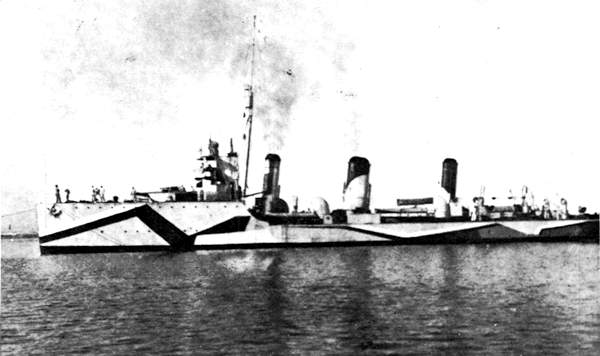
Indomito in 1916
Their armament was modified in 1914, adding two more 17.7in TT; during World War One when guide rails for minelaying were ordered (10 mines); and in 1918-19, when the original guns were replaced by 5—4in/35 plus 1-40mm/39 MG. During World War One their oil capacity was augmented from 100 to 128 tonnes, with an expected greater endurance, but full load displacement reached nearly 900 tonnes so speed and range were reduced.
All were reclassed as torpedo-boats on 10 October 1929.
Intrepido sank off Valona by a mine laid from the German submarine 14. Impetuoso sank in the Otranto Straits, by torpedoes from the Austrian submarine U 17. Insidioso was discarded on 18 September 1938 but reinstated in the Naval List from 1 March 1941: As mofified she had only two funnels, top speed down to 24kts and a single 1—4in/45, four Breda 20mm/70 AA and two Breda 13.2mm AA HMGs, but they kept their two 21-in torpedo tubes, with a complement of 5 officers and c70 crew. She served as a target ship for the submarine school at Pola, and escort ship in the Adriatic and as an ASW patrol craft. She was scuttled by her own crew on 10 September 1943 at Pola, but repaired by the Germans and commissioned on 8 November as TA 21 “Wildfang”; rearmed with two 4in/35, nine 20mm MGs FLAK 38, and keeping her TTs. She was damaged by British aircraft MG fire on 9 August 1944, repaired and definitively sunk at Fiume by torpedo from a US plane. Quite a career for a ship launched in 1913.
 INDOMITO (ID)
INDOMITO (ID)
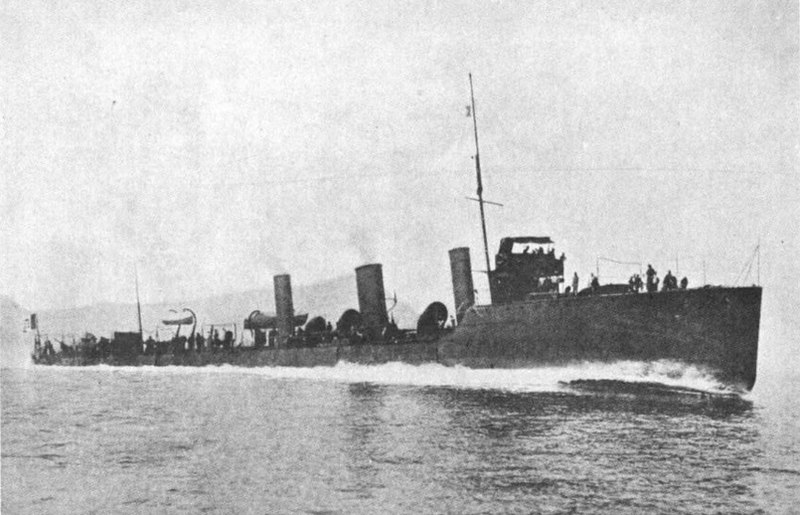
Indomito was launched on 10.5.12. and she was fully mobilized for oprtation from 23 May 1915. Under command of Capitano di corvetta Lodolo she was in the same unit as her sisters Impavido, Impetuoso, Insidioso, Intrepido, and Irrequieto, the 2nd Destroyer Squadron (Capitano de fregata P. Orsini), based at Taranto. On 9 June they sortied woth the scout cruiser Quarto, as well as the other squadron composed of the destroyers Animoso, Ardente, Ardito, Audace to escort the armored cruisers Giuseppe Garibaldi and Vettor Pisani for a bombardment of the Cape Rodon and Shëngjin lighthouses, Albania.
On 22 November 1915, Indomito’s squadron carried a British commissariat commission, but were detached to chase after Austro-Hungarian Navy vessels that just sank the sailship Gallinara and steamship Palatino.
On 3 December the squadron sailed in escort of tropships from Brindisi to Albania, with the Re Umberto and Valparaiso (1,800 men and 150 draft animals) towards Shëngjin (San Giovanni di Medua). Re Umberto hit a mine from UC-14, broke in two and sank in 15 minutes, 712 men were rescued (most of the men she carried).
On 9 December 1915 Indomito and Euro escorted Sterope from Taranto to Vlorë (Valona).
On 23 February 1916 Indomito, Impetuoso, Ardito, escorted the cruisers Libia and Puglia off Durrës (Durazzo) in cover for the “Savona” Brigade.
On 11 December, Indomito and Ardente escorted the battleship Regina Margherita to Italy whe she hit two mines off Vlorë and capsized, sank in seven minutes with 674, 275 rescued. Later Indomito underwent had an overhaul at Venice.
On the night of 14–15 May 1917 the Battle of the Strait of Otranto seeing armed fishing boats patrolling the ASW barrier being sunk as a diversionary action, while another attack took place on an Italian convoy to Albania. At 04:10 on 15 May, Indomito, Impavido, Insidioso, and the cruiser Marsala, the scouts Aquila and Carlo Alberto Racchia plus HMS Liverpool were prepared to depart from Brindisi, leaving at 05:30, later joined by HMS Dartmouth and two destroyers, seeing the Austrians at 07:45, the DD Balaton and Csepel. She stayed with Aquila when engaging these at 08:15 and during the gunfire, Balaton and Aquila were damaged. The two Austro-Hungarian destroyers managed to get back, the Italians stopped the pursuit as being engage by shore batteries.
On 9 June 1917 Indomito, under Captain Da Sacco, escorted a convoy of to Plataria, Parga, Murzo, and Igoumenitsa (Epirus) carrying 1,700 men, 200 draft animals, 300 tons of supplies.
On 16 July with Impavido, Insidioso and the cruisers Carlo Alberto Racchia, Augusto Riboty ensured distant support during an Italian air attack against Durrës.
On 18 October an Austro-Hungarian Navy force (Helgoland, 6 destroyers) left Cattaro to prey on Italian convoys, found none, and instead went off Brindisi to entice and lure the Italians into an ambush by U-32 and U-40. Indomito sortied with Aquila, Sparviero, Antonio Mosto and Giuseppe Missori, British light HMS Gloucester and HMS Newcastle, French Navy DDs Bisson, Commandant Bory, Commandant Rivière, but the ambush failed and the Austro-Hungarians escaped.
On 10–11 February 1918 Indomito sortied with Guglielmo Pepe, Cesare Rossarol, Ippolito Nievo for another support of a raid against Durrës led by MAS 9 and MAS 20 towed by 37 PN and 38 PN until Bad weather cancelled it.
After the war, Indomito′s armament was revised (five 102 mm (4 in)/35-caliber guns, single 40 mm/35, 4x 450 mm (17.7 in)TTs in twin banks) and she reclassified as a torpedo boat in 1929, but stricken on 11 July 1937.
 IMPAVIDO (IV)
IMPAVIDO (IV)
On 23 May 1915 Impavido was in the 2nd Destroyer Squadron under command of Capitano de fregata P. Orsini based at Taranto and was assigned to the 3rd Group, 4th Naval Division while Orsini was promoted to capitano di vascello and took command of the 3rd Group and 2nd Destroyer Squadron.
At 01:00 on 6 July 1915 Impavido sailed from Venice for an offensive reconnaissance to the east and back. At 04:30, 30 nm (56 km; 35 mi) east of Chioggia they were to meet the cruiser Amalfi and another DD squadron led by Bersagliere in order to sweep the Gulf of Venice, looking for Austro-Hungarian ships. Amalfi was torpedoed by U-26, sank in ten minutes. It was learned soon after that an Austro-Hungarian Navy bombarded the Palagruža (Pelagosa) archipelago in the night of 16–17 August 1915, so both Impavido, Animoso, Ardito, Intrepido, Quarto, sailed north of Brindisi–Cattaro line and reached Palagruža at 10:00 on 17 August 1915 but missed the Austrians.
On 8 June 1916 Impavido (Captain Ruggiero) departed Vlorë (Valona) with Insidioso, Libia, Espero and Pontiere to escort the armed merchant cruiser Principe Umberto and troopship Romagna carrying the 55th Infantry Regiment to Italy. U-5 hit Principe Umberto in the stern and she sank rapudly 15 nautical miles (28 km; 17 mi) SW of the Karaburun Peninsula (Cape Linguetta) carrying with her 1,926 of 2,821 men on board. Survivors were rescued but U5 escaped.
On 25 June 1916 Impavido sortied with Insidioso, Irrequieto, Audace and the cruiser Marsala, in distant support of the Durrës (Durazzo) raid.
On 24 Decembershe sortied with Ippolito Nievo and Carlo Mirabello, in support of MAS 3 and MAS 6, which for another Durrës cancelled as MAS 6 suffered collided with wreckage short of the port.
On the night of 14–15 May 1917 Immpavido took part in the Battle of the Strait of Otranto.
On 16 July 1917 she sailed with the scout Augusto Riboty and cruiser Carlo Alberto Racchia, in distant support raid against Durrës.
Post-World War I her armament was revised, she was reclassed as TB in 1929, stricken 1 September 1937.
 IMPETUOSO
IMPETUOSO
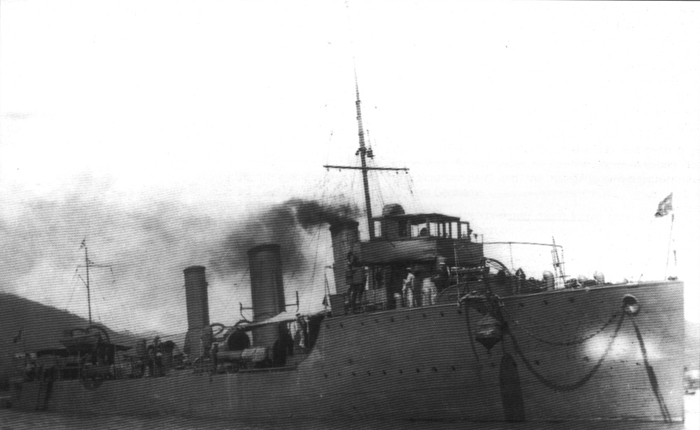
Impetuoso (Capitano di corvetta Giuseppe Sirianni) as part of the 2nd Destroyer Squadron commanded by P. Orsini at Taranto, adn she toook part in the bombardments at Cape Rodon and Shëngjin, as well as the 3 December 1915 escort of supply convoys to Albania, rescuing later suvivors of Re Umberto.
On 8 December 1915 she escorted Palermo to Vlorë (Valona) and on 11–12 December 1915 the steamer Valparaiso to the Valona.
On 23 February 1916 with Insidioso she shelled Austro-Hungarian artillery positions on the mountain Sasso Bianco, Dolomites in the evacuation of Durazzo and the “Savona” Brigade.
On 9 July 1916 (captain Ponza di San Martino) she sailed with Irrequieto to shase off the scout cruiser Novara from the Otranto Barrage, sinking naval drifters, but she escaped to Cattaro.
At 15:30 on 10 July 1916 Impetuoso and Insidioso were patrolling the barrage when attacked by U-17 attacked them. Impetuoso’s officer on watch sighted the wake of a torpedo at just 150 metres (160 yd) and had not time for evasive action, she was hit and broke in tow, sinking with 37 souls aboard, 51 being rescued.
 INSIDIOSO (IS)
INSIDIOSO (IS)
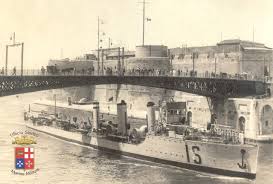 Insidioso (Capitano di corvetta U. Bucci) was part of the 2nd Destroyer Squadron. On 9 June 1915, she took part in the operations agains San Giovanni di Medua.
Insidioso (Capitano di corvetta U. Bucci) was part of the 2nd Destroyer Squadron. On 9 June 1915, she took part in the operations agains San Giovanni di Medua.
On 3 December 1915 she escorted supply convoys to Albania and rescued men from Re Umberto and on 8 December she escorted Palermo, and later under Captain Bucci, the steamer Valparaiso.
On 23 February 1916 she shelled Austro-Hungarian artillery positions on Sasso Bianco during the evacuation of Durazzo and positions at Rrashbull in Albania.
On 8 June, she escorted the armed merchant cruiser Principe Umberto and troopship Romagna and rescued survivors from the first when sank by U-5.
On 25 June, she took part in a distant support raid.
On 10 July, she saw Impetuoso sank by U-17 off the Otranto barrage and rescued part of her crew.
On 14–15 May 1917 she took part in the Battle of the Strait of Otranto.
On 11 June, and later with Irrequieto, Airone and Ardea she was in distant support for two airborne raids against Durrës.
On 18 October, she rushed in pursuit of Helgoland and Lika leading them to an amnbush by U-32 and U-40 but they escaped.
Postwar she was rearmed, reclassified as torpedo boat in 1929 but stricken in 1938. However she was notbroken up like the others.
From June 1940 she was still not scrapped and by early 1941, Insidioso resumed service and after the British submarine HMS Thorn sank Medusa on 30 January 1942, she attempted to rescue her crew trapped within the submarine′s wreck without success. She mostly served as target ships for Italian submarines and did a few patrols.
After the armistice of Cassibile on 8 September 1943 she was seized by Germany at Pola. Renamed TA21, rearmed, she joined the Kriegsmarine on 8 November 194, multiplying attacks on allied convoys and operations, until baldy damaged by a British aircraft off Istria on 9 August 1944. She was towed to Fiume and under repairs when finished off by an American torpedo bomber on 5 November 1944. She was was refloated and scrapped in 1947.
 INTREPIDO
INTREPIDO
Intrepido was part of the 3rd Destroyer Squadron and after shakedown and training in 1913, took part in training cruises in the Eastern and Western Mediterranean but was transferred to the 2nd Destroyer Squadron in 1914 and started minesweeping operation in the southern Adriatic Sea.
By 23 May 1915 he was commanded Capitano di corvett De Grenet.
On 5 June 1915, she escorted HMS Dublin for a raid on Donzella, Dalmatia. On 9 June she was in the raid against San Giovanni di Medua.
On 17 July 1915 she shelled the radiotelegraph station on Šipan (Giuppana), Dalmatia as part of the 5th Naval Division until Vettor Pisani spotted an Austro-Hungarian submarine. Later U-4 sank Giuseppe Garibaldi, and Intrepido rescueed some of the 525 men (out of 578). She was detached as Palagruža (Pelagosa) was shelled by the Austrian, but arrived too late on 17 August.
On 3 December 1915 under Capitano di corvetta Leva she escorted Re Umberto and Valparaiso but at 14:00 on 4 December while returning from her patrol she struck a mine south of the Karaburun Peninsula. Her bow was blow off, she lost part of her forward superstructure, (1 officer, 3 ratings killsed many wounded including the captain)but she was close enough to the short to be beached near Point Linguetta. Unsalvageable she was stripped of her gunsand torpedo tubes, abandoned, her wreck sinking later in deeper water.
 IRREQUIETO (IR)
IRREQUIETO (IR)

Irrequieto (Capitano di corvetta Moreno) was in the 2nd Destroyer Squadron when the war broke out. She took part in the San Giovanni di Medua raid, and later rescued men from Giuseppe Garibaldi.[4]
On 3 December 1915 she escorted Re Umberto and Valparaiso and rescued men from the former.
On 24 February 1916 she escorted the auxiliary cruisers Città di Catania and Città di Siracusa to shell advancing Austro-Hungarian troops in Albania towards Durrës (Durazzo). She also shelled the mountain Sasso Bianco. On 25 June she took part in the first raid against Durrës. On 9 July 1916 she chased Novara, rampaging the Otranto Barrage and on 11 June 1917 she covered a seaplane raid over Durrës. Postwar she was rearmed, reclassed as TB in 1928 and stricken on 11 October 1937.
 ARDITO (AI/AO/AT)
ARDITO (AI/AO/AT)
Ardito wuth Animoso, Ardente, Audace, and Francesco Nullo were in the 1st Destroyer Squadron, at Brindisi under command of Capitano di corvetta Caccia. On 24 May she took part in an ASW patrol in the Gulf of Drin, Albania and off Cattaro. On 9 June 1915 with the 2nd squadron and Quarto she escorted Giuseppe Garibaldi and Vettor Pisani to San Giovanni di Medua.
On 11 July 1915 she escorted Quarto for a raid on Pelagosa and landed troops before the occupation force. The archipelago’s entire garrison was captured.
On 17 July 1915 she sailed with Garibaldi, Pisani, and the destroyers Strale, Airone, Arpia, Astore, Calliope, Clio, armored cruiser Varese, TBs Alcione, Centauro, and Cigno, or a raid on the Ragusa–Cattaro railway. The attack ceased when was sighted an Austro-Hungarian submarine at 04:25 and U-4 indeed sank Giuseppe Garibaldi.
In the 11–12 December 1915 night Ardito and Simone Schiaffino escorted Epiro and Molfetta from Brindisi to Durazzo for the Serbian Army.
On 23 February 1916, Ardito, Indomito, Impetuoso, Libia and Puglia covered the retreat of the “Savona” Brigade. On 24 February 1916 with the AMC Città di Siracusa and Città di Catania and following days they bombarded Austro-Hungarian artillery positions on Sasso Bianco.
On 2 August 1916, Ardito and French destroyers Bisson, Commandant Bory, and Commandant Rivière supported MAS 6, 33 PN and 37 PN, on a raid on Durazzo, with one steamer claimed sunk.
On 11 May 1917 Ardito (Capt. Gottardi) left Venice with Animoso, Ardente, Audace and Giuseppe Cesare Abba to intercept the DD Csikos and 78 T, 93 T, and 96 T but they were not engaged before reaching back Pola.
On 29 September 1917 Ardito (Capitano di corvetta Inigo Campioni, future squadron admiral) sailed with Ardente and Audace, Giuseppe Cesare Abba, Sparviero, Giovanni Acerbi, Vincenzo Giordano Orsini, and Francesco Stocco in a shelling bombing raid against Pola. They crossed fire also with Huszar, Streiter, Turul, and Velebit and four torpedo boats.
On 28 November 1917, she sailed under cover of reconnaissance seaplanes, to intercept the DDs Huszar, Streiter, Dikla, four TBs that just shelled the railway near the Metauro.
On 10 May 1918 she sailed to Porto Levante to support a bogus incursion into Bakar (Buccari) by MAS.
Postwar, her armament was revised, she was reclassed as TB on 1 October 1929, stricken on 2 October 1931.
 ARDENTE (AE/AR)
ARDENTE (AE/AR)
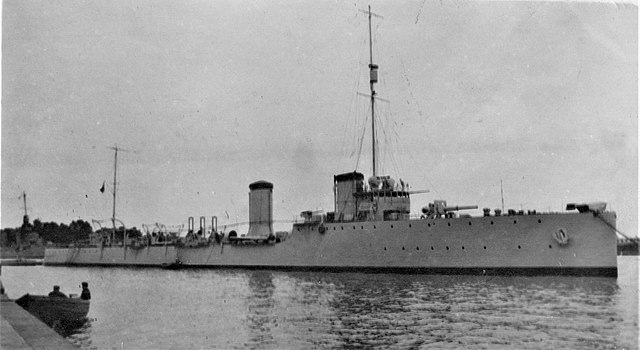
Ardente was like her sister in the 1st Destroyer Squadron at Brindisi and took part in the same missions. On 17 July 1915, the bombardment of the Ragusa–Cattaro railway. On 3 August 1916 she was in distant cover for a raid on Durazzo but diverted to Molfetta, under bombardment by the cruiser Aspern, destroyers Warasdiner and Wildfang, TB 80 and TB 85. She however suffered a mechanical breakdown and fell back. Giuseppe Cesare Abba was joined by French destroyers but clash was inconclusive.
On 11 December 1916 she was in the raid on Valona, escortin the battleship Regina Margherita which hit two mines.
On 11 May 1917 she sailed on interception of Csikos and 78 T, 93 T, and 96 Tbut broke the prusuit off Pola.
On 29 September she covered a bombing raid against Pola and crossed fire briefly with the DDs Streiter, Velebit, Huszar and Turul, four torpedo boats.
On 16 November she intercepted a shelling raid from Asutrian coastal defense ships Wien and Budapest on Cortellazzo near the Piave River. MAS 13 and MAS 15 and Italian aircraft, submarines F11 and F13, disrupted it.
On 18 November, she shelled Austro-Hungarian lines between Caorle and Revedoli and on 28 November 1917, chased an Austro-Hungarian formation shelling the railway near the Metauro. On 10 February 1918 she took par tin the mock raid on Buccari. Postwar she was rearmed, reclassified as TB on 1 October 1929, stricken on 11 March 1937.
Read More/Src
Books
Favre, Franco. La Marina nella Grande Guerra. Le operazioni navali, aeree, subacquee e terrestri in Adriatico
Fraccaroli, Aldo (1985). “Italy”. In Gray, Randal (ed.). Conway’s All the World’s Fighting Ships 1906–1921. Annapolis NIP
Links
https://uboat.net/wwi/ships_hit/ship.html?shipID=2995
http://www.dreadnoughtproject.org/tfs/index.php/Indomito_Class_Destroyer_(1912)
https://www.iantdexpeditions.it/spedizioni/in2007/stor22.htm
https://web.archive.org/web/20110104190441/http://www.marinai.it/contatti/rmita.pdf
https://en.wikipedia.org/wiki/Indomito-class_destroyer
https://www.marina.difesa.it/noi-siamo-la-marina/mezzi/mezzi-storici/Pagine/EFGHI/indomito01.aspx
http://www.naviecapitani.it/gallerie%20navi/navi%20militari%20storiche/schede%20navi/A/ARDENTE/C.T.%201913.htm
https://www.marina.difesa.it/noi-siamo-la-marina/mezzi/mezzi-storici/Pagine/ABCD/ardente.aspx
https://www.marina.difesa.it/noi-siamo-la-marina/mezzi/mezzi-storici/Pagine/ABCD/ardito.aspx

 Latest Facebook Entry -
Latest Facebook Entry -  X(Tweeter) Naval Encyclopedia's deck archive
X(Tweeter) Naval Encyclopedia's deck archive Instagram (@navalencyc)
Instagram (@navalencyc)





 French Navy
French Navy Royal Navy
Royal Navy Russian Navy
Russian Navy Armada Espanola
Armada Espanola Austrian Navy
Austrian Navy K.u.K. Kriegsmarine
K.u.K. Kriegsmarine Dansk Marine
Dansk Marine Nautiko Hellenon
Nautiko Hellenon Koninklije Marine 1870
Koninklije Marine 1870 Marinha do Brasil
Marinha do Brasil Osmanlı Donanması
Osmanlı Donanması Marina Do Peru
Marina Do Peru Marinha do Portugal
Marinha do Portugal Regia Marina 1870
Regia Marina 1870 Nihhon Kaigun 1870
Nihhon Kaigun 1870 Preußische Marine 1870
Preußische Marine 1870 Russkiy Flot 1870
Russkiy Flot 1870 Svenska marinen
Svenska marinen Søværnet
Søværnet Union Navy
Union Navy Confederate Navy
Confederate Navy Armada de Argentina
Armada de Argentina Imperial Chinese Navy
Imperial Chinese Navy Marinha do Portugal
Marinha do Portugal Mexico
Mexico Kaiserliche Marine
Kaiserliche Marine 1898 US Navy
1898 US Navy Sovietskiy Flot
Sovietskiy Flot Royal Canadian Navy
Royal Canadian Navy Royal Australian Navy
Royal Australian Navy RNZN Fleet
RNZN Fleet Chinese Navy 1937
Chinese Navy 1937 Kriegsmarine
Kriegsmarine Chilean Navy
Chilean Navy Danish Navy
Danish Navy Finnish Navy
Finnish Navy Hellenic Navy
Hellenic Navy Polish Navy
Polish Navy Romanian Navy
Romanian Navy Turkish Navy
Turkish Navy Royal Yugoslav Navy
Royal Yugoslav Navy Royal Thai Navy
Royal Thai Navy Minor Navies
Minor Navies Albania
Albania Austria
Austria Belgium
Belgium Columbia
Columbia Costa Rica
Costa Rica Cuba
Cuba Czechoslovakia
Czechoslovakia Dominican Republic
Dominican Republic Haiti
Haiti Hungary
Hungary Honduras
Honduras Estonia
Estonia Iceland
Iceland Eire
Eire Equador
Equador Iran
Iran Iraq
Iraq Latvia
Latvia Liberia
Liberia Lithuania
Lithuania Mandchukuo
Mandchukuo Morocco
Morocco Nicaragua
Nicaragua Persia
Persia San Salvador
San Salvador Sarawak
Sarawak Uruguay
Uruguay Venezuela
Venezuela Zanzibar
Zanzibar Warsaw Pact Navies
Warsaw Pact Navies Bulgaria
Bulgaria Hungary
Hungary

 Bundesmarine
Bundesmarine Dutch Navy
Dutch Navy Hellenic Navy
Hellenic Navy Marina Militare
Marina Militare Yugoslav Navy
Yugoslav Navy Chinese Navy
Chinese Navy Indian Navy
Indian Navy Indonesian Navy
Indonesian Navy JMSDF
JMSDF North Korean Navy
North Korean Navy Pakistani Navy
Pakistani Navy Philippines Navy
Philippines Navy ROKN
ROKN Rep. of Singapore Navy
Rep. of Singapore Navy Taiwanese Navy
Taiwanese Navy IDF Navy
IDF Navy Saudi Navy
Saudi Navy Royal New Zealand Navy
Royal New Zealand Navy Egyptian Navy
Egyptian Navy South African Navy
South African Navy






























 Ukrainian Navy
Ukrainian Navy dbodesign
dbodesign